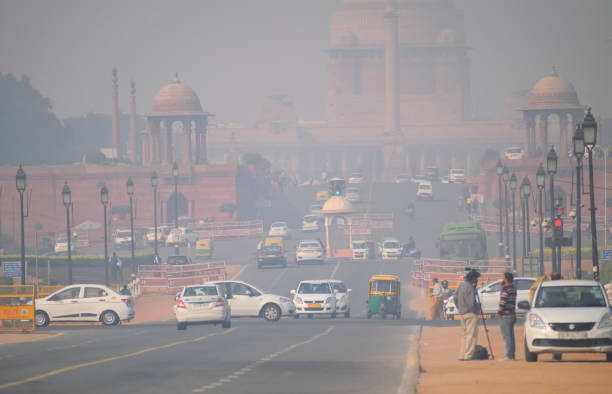Delhi’s Air Quality Remains ‘Very Poor’ as AQI Reaches 315 at Jawaharlal Nehru Stadium Amidst Rising Pollution Levels
2 min read
Delhi, India - November 21, 2017: Heavy traffic on the streets of New Delhi in New Delhi covered in heavy smog.
As Delhi battles increasing pollution levels, the Air Quality Index (AQI) at Jawaharlal Nehru Stadium recently recorded a concerning 315, marking it within the “very poor” category. This uptick aligns with typical post-Diwali pollution spikes, compounded by seasonal factors and regional stubble burning, which frequently elevate particulate matter in Delhi’s air. Today, Delhi’s AQI, impacted heavily by PM2.5 levels, not only poses health risks to residents but also demands immediate interventions for air quality improvement.
Contributing Factors to Delhi’s Poor Air Quality
Delhi’s air quality tends to worsen significantly each winter due to several compounding factors. Seasonal crop residue burning in neighboring states, such as Punjab and Haryana, plays a substantial role in deteriorating Delhi’s air. These activities emit high levels of PM2.5 and PM10 particles, adding to the already high baseline of urban pollution from vehicles, construction, and industry.
Weather patterns further contribute to the problem. Cooler temperatures and reduced wind speeds trap pollutants close to the ground, resulting in sustained poor air quality levels across the city. At Jawaharlal Nehru Stadium and surrounding areas, AQI levels have consistently been in the “very poor” and “severe” categories for weeks, signaling a public health hazard.
Health Implications of a “Very Poor” AQI Level
According to experts, exposure to an AQI of 315 (PM2.5 concentration) can cause respiratory issues and exacerbate pre-existing conditions like asthma and bronchitis. The World Health Organization (WHO) recommends an average PM2.5 concentration limit of 15 µg/m³ over 24 hours. However, the current levels are reported to be several times above this threshold, putting sensitive groups—like children, the elderly, and those with pre-existing respiratory issues—at significant risk.
For instance, common health advisories for residents during this time include:
- Avoiding outdoor activities: Staying indoors can help limit exposure to harmful air pollutants.
- Using air purifiers: Indoor air purifiers with HEPA filters can reduce indoor air pollution.
- Wearing masks: N95 masks are recommended for those who need to go outdoors, especially in high-traffic areas like sports stadiums and city centers.
Government and Civic Response
The Delhi government has implemented the Graded Response Action Plan (GRAP), a framework designed to tackle escalating pollution levels in phases. As per this plan, several emergency measures are activated as AQI levels rise, such as halting construction activities, imposing restrictions on vehicle emissions, and initiating water-spraying mechanisms on city roads to settle dust. Despite these measures, experts argue that long-term strategies are essential for sustained air quality improvement, as temporary solutions only provide minor relief.
Prospects for Improvement
Weather forecasts for Delhi over the next few days predict a slight improvement in AQI levels as wind speeds increase, helping to disperse pollutants. However, sustained improvement will require broader policy measures, stricter enforcement of anti-pollution norms, and cooperation between states to manage agricultural burning.
For real-time air quality updates and precautionary health advisories, visit AQI India and Prana Air.




